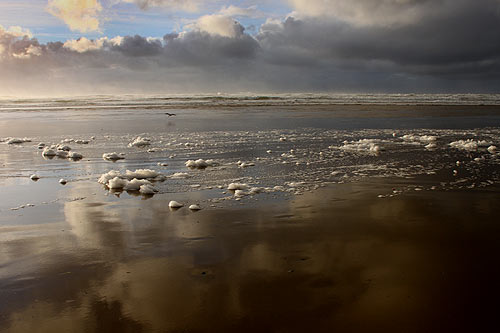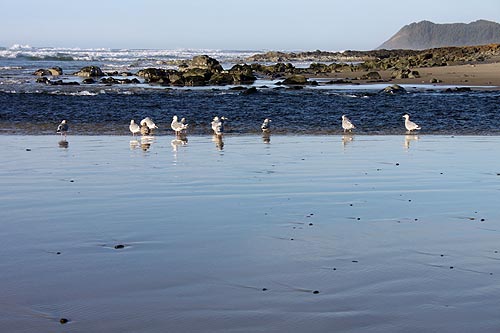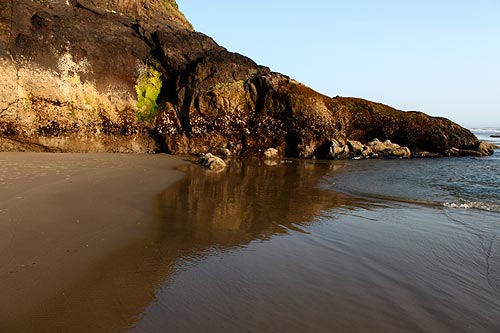 |
Scientists Worry About Tsunami Preparedness Along Oregon, Washington Coasts
Published 06/04/2015 at 5:21 PM PDT
By Oregon Coast Beach Connection staff

(Oregon Coast) – Researchers with the U.S. Geological Survey, University of Colorado Boulder, and California State University, Sacramento, say many coastal areas along the Pacific Northwest are still insufficiently prepared for the big tsunami that geologists consider inevitable. In the study, they said tens of thousands of people in California, Oregon and Washington coastal areas may not have time to evacuate because they live in low-lying areas. (Above: Arch Cape, near Cannon Beach).
“All coastal communities in the U.S. Pacific Northwest are vulnerable to varying degrees to tsunami hazards from a Cascadia subduction zone earthquake,” said Dr. Nathan Wood, lead author of the study and scientist with the USGS. “Having a better sense of how a community is specifically vulnerable provides officials with the ability to develop outreach, preparedness, and evacuation plans that are tailored to local conditions and needs.”
The authors released their findings this spring in the scientific journal “Proceedings of the National Academy of Sciences.” Looking at 49 cities and 17 counties from northern California to the top of Washington State, they said all were directly threatened by the massive tsunami wave expected when the Cascadia subduction zone produces an earthquake – one that is predicted to equal that of the Japan quake in 2011. Scientists examined the number of people and businesses exposed to to tsunami hazards along with demographics and how long it would take to evacuate to higher ground in each city.
They concluded that coastal communities fell into three different groups, based on population and how long an evacuation would take.
Communities in the first group have relatively small populations in tsunami hazard zones and likely have sufficient time to evacuate, suggesting the need for tsunami education. A second group of communities has large populations in tsunami-hazard zones and likely will have sufficient time to evacuate if people are able to move quickly, suggesting a need for evacuation training. The third group of communities has moderate-sized populations in tsunami hazard zones, but insufficient time for everyone to evacuate before wave arrival, suggesting the need for solutions such as vertical-evacuation refuges.
John Schelling, Earthquake & Tsunami Program Manager for the Washington Military Department’s Emergency Management Division, said this reaffirms there is more work to do in each town. There is a need for more public education in showing residents – and visitors – how to reach safer ground.
“Perhaps more importantly, this research confirms the need for continued implementation of the multi-agency collaboration known as 'Project Safe Haven' and ensuring communities on the Washington coast have tsunami vertical evacuation refuges, from which to escape a tsunami,” Schelling said.
Wood said one method that will help is having communities with similar tsunami hazard vulnerabilities build a network, with officials sharing success stories of risk reduction and other collaborations to that end.
“Our goal was to provide officials with actionable information for saving lives with community-specific interventions,” Wood said. See Live Earthquake, Tsunami Updates from Oregon Coast, Washington. B.C., California, Alaska. More on the Oregon coast below:





More About Oregon Coast hotels, lodging.....
More About Oregon Coast Restaurants, Dining.....
LATEST Related Oregon Coast Articles
Oregon Coast, Valley and Likely Washington Coast to Get Some Aurora Borealis ... |
Back to Oregon Coast
Contact Advertise on BeachConnection.net
All Content, unless otherwise attributed, copyright BeachConnection.net Unauthorized use or publication is not permitted
Secrets of the Season |
Unusual Travel Articles TravelParanormal.com allows you to submit your own creepy tale or debunk one - or see up-to-the-minute news headlines about travel and the paranormal. News Headlines from All Over Oregon Need to scan Oregon headlines? Constantly updated news from all over Oregon: a comprehensive, up-to-the-minute display of news headlines from a variety of media Oregon Coast Oceanfront Lodging, Hotels, Rentals |







































